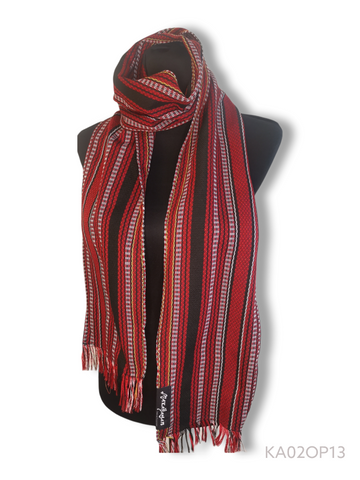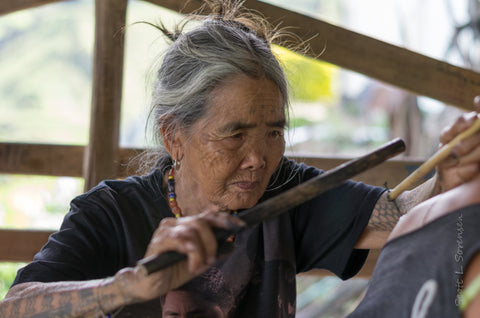By: Carlo Castillo
The Kalinga people have been one of the most revered indigenous ethnic groups in the Philippines. They have been residing in the Northern region of the country, specifically in the Cordillera Mountain Range. The Kalingas have a tight-knit family and treat elders with high respect.
The term ‘Kalinga’ is considered to be from the Ibanag and Gaddang languages and means “headhunter.” Invaders and even neighbors feared the Kalinga people because of their headhunter reputation. Headhunting was one of their most usual factors for attaining leadership and respect.
The Kalingas have been living on the terraced or leveled areas on the slopes of mountains. They have chosen locations close to rivers and streams to have access to free and clear waters. The Chico, Tanduan, and Pasil rivers are their main sources of water. The ricefields or ‘payaw’ and the swidden farm or ‘uma’ are their main sources of livelihood. They raise cattle and poultry while they also utilize the rivers for fishing. Hunting has been their tradition and is continued by the male members of their tribe.
Coconut, bananas, coffee, and fruit trees are typically grown by the Kalingas while they plant sugarcane to turn into wine or ‘basi’. Aside from growing a variety of trees, the Kalinga people also utilize cloth and basket weaving, pottery, and blacksmithing to keep their economic activities moving. They are famous for their hand-woven textiles and beautiful beaded jewelry.
Kalinga Weaving
Kalinga weavers utilize indigenous raw materials taken from abaca, cogon, maguey, and banana then braid them with cotton or polyester textile. There are new innovative products finding demand even in international markets that include dining accessories like placemats and table runners. The most usual items produced are sashes, skirts, capes, loincloths, headbands, blouses, blankets, underskirts, pouches, and bags.
Kalinga weaving was discovered way back in the 18th century. It has continued to evolve through the centuries and has produced the more fashionable style called Ginamat design. Ginamat is a pattern that is twilled and decorated using silk embroidery.

Check out Kalinga scarves perfect for gifts.
Kalinga Clothing
The typical Kalinga clothing for men is called the ‘bahag’ (loincloths) while women usually wear the ‘kain’ or a colorful garment that covers from the waist down which is like the ‘tapis’ from different parts of the Philippines. The women also have tattoos that are commonly inked from the arms going to the shoulders. They also use colorful ornaments such as necklaces, earrings, and bracelets. These are typically seen on important festive days.

Credits to theclamorofkalinga.blogspot.com
The bahag is a long woven material that is 3 to 5 feet long and 10 to 15 inches wide. The main purpose of the bahag is to cover the private parts. It is secured firmly from the waist so that it won’t fall off and keep the male organs covered safely. Traditionally, upper clothes are not common in Kalinga men as Tattoos are commonly decorated on the upper exposed portion of the body.
The female Kalinga costume is made of a large rectangular woven material that is about 3-4 feet long and 3-5 feet wide. This is worn just like a skirt. Back in the day, women also had no upper clothing but due to the influence of the times, the blouses are worn by the Kalinga women now. Some villages still have some topless married women but the younger generation has chosen to wear blouses for the sake of decency. Going out topless for them before was not indecent as that was part of their culture for centuries.
Usually, the topless bodies of the Kalinga women are decorated by native beads called ‘bongol’. A woman’s status is usually indicated by the number of beads and the weight of the bongol. The nobler or richer Kalinga women typically have multi-layered or heavier bongols.
The Kalinga Body Art
For the Kalingas, getting a tattoo means so much compared to the usual reasons why people get tattoos today. For centuries, the Kalingas have been practicing body art and have kept it as a staple of their rich Filipino tradition. Kalinga men and women have varying reasons for getting their tattoos.

Credits to Commons.Wikimedia.org
Kalinga Tattoo for Men
Known to be a warrior tribe for centuries, the Kalingas have been known to defend and fight for their community. The headhunting Kalinga warriors were ruthless and kept count on their number of kills. To celebrate and commemorate their victories, the Kalinga warriors would acquire special markings with patterns as tattoos. This turned out to be their sign of bravado.
Tattooing the body of a returning warrior was not done for fun but to showcase the number of wars, enemies killed and even the skill level displayed in battle. In a way, the tattoo for each warrior is rightfully earned and that’s what makes each warrior unique.
The most usual designs included representations of the centipede or python snake. Sometimes Northern Luzon’s rice terraces would also be seen as tattoos.
Kalinga Tattoo for Women
For Kalinga women, the story of getting a tattoo is quite different. Having tattoos decorated on their bodies is a sign of strength and beauty. Kalinga parents would pay a tattoo artist or ‘Mambabatok’ to get ornate tattoos decorated on their daughter’s bodies to make them more beautiful. Even at the early age of 13, Kalinga girls are sent to a ‘mambabatok’ so that they could get a beautiful tattoo.
Rich Kalinga Tradition: Worth Preserving
Filipino cultural tradition is worth preserving and the tradition of the Kalinga people offers so much value. From Kalinga weaving, clothing, and body art, these contributions to Philippine culture help create diversity in the identity of the Filipino. From warrior tribes to key contributors to economic and historical aspects in society, the Kalinga people have continued to draw interest even from foreigners and locals alike. Apo Whang-od, the famous mambabatok of the Kalinga community, lives on as one of the pillars of Kalinga culture and tradition.
Learning from indigenous ethnic groups such as the Kalinga people is vital in understanding the rich history of the Philippines. Here’s to hoping that these traditions live on for generations to come.


Share:
Revisiting Traditional Filipino Clothing's Cultural Abundance
Barong Tagalog for Men and Women from the Philippines | What It Is and How to Buy It